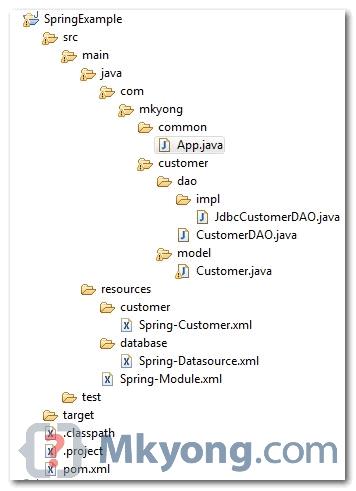Spring + JDBC example
Posted 与f
tags:
篇首语:本文由小常识网(cha138.com)小编为大家整理,主要介绍了Spring + JDBC example相关的知识,希望对你有一定的参考价值。
In this tutorial, we will extend last Maven + Spring hello world example by adding JDBC support, to use Spring + JDBC to insert a record into a customer table.
1. Customer table
In this example, we are using mysql database.
CREATE TABLE `customer` ( `CUST_ID` int(10) unsigned NOT NULL AUTO_INCREMENT, `NAME` varchar(100) NOT NULL, `AGE` int(10) unsigned NOT NULL, PRIMARY KEY (`CUST_ID`) ) ENGINE=InnoDB AUTO_INCREMENT=2 DEFAULT CHARSET=utf8;
2. Project Dependency
Add Spring and MySQL dependencies in Maven pom.xml file.
File : pom.xml
<project xmlns="http://maven.apache.org/POM/4.0.0" xmlns:xsi="http://www.w3.org/2001/XMLSchema-instance" xsi:schemaLocation="http://maven.apache.org/POM/4.0.0 http://maven.apache.org/maven-v4_0_0.xsd"> <modelVersion>4.0.0</modelVersion> <groupId>com.mkyong.common</groupId> <artifactId>SpringExample</artifactId> <packaging>jar</packaging> <version>1.0-SNAPSHOT</version> <name>SpringExample</name> <url>http://maven.apache.org</url> <dependencies> <!-- Spring framework --> <dependency> <groupId>org.springframework</groupId> <artifactId>spring</artifactId> <version>2.5.6</version> </dependency> <!-- MySQL database driver --> <dependency> <groupId>mysql</groupId> <artifactId>mysql-connector-java</artifactId> <version>5.1.9</version> </dependency> </dependencies> </project>
3. Customer model
Add a customer model to store customer’s data.
package com.mkyong.customer.model; import java.sql.Timestamp; public class Customer { int custId; String name; int age; //getter and setter methods }
4. Data Access Object (DAO) pattern
Customer Dao interface.
package com.mkyong.customer.dao; import com.mkyong.customer.model.Customer; public interface CustomerDAO { public void insert(Customer customer); public Customer findByCustomerId(int custId); }
Customer Dao implementation, use JDBC to issue a simple insert and select statement.
package com.mkyong.customer.dao.impl; import java.sql.Connection; import java.sql.PreparedStatement; import java.sql.ResultSet; import java.sql.SQLException; import javax.sql.DataSource; import com.mkyong.customer.dao.CustomerDAO; import com.mkyong.customer.model.Customer; public class JdbcCustomerDAO implements CustomerDAO { private DataSource dataSource; public void setDataSource(DataSource dataSource) { this.dataSource = dataSource; } public void insert(Customer customer){ String sql = "INSERT INTO CUSTOMER " + "(CUST_ID, NAME, AGE) VALUES (?, ?, ?)"; Connection conn = null; try { conn = dataSource.getConnection(); PreparedStatement ps = conn.prepareStatement(sql); ps.setInt(1, customer.getCustId()); ps.setString(2, customer.getName()); ps.setInt(3, customer.getAge()); ps.executeUpdate(); ps.close(); } catch (SQLException e) { throw new RuntimeException(e); } finally { if (conn != null) { try { conn.close(); } catch (SQLException e) {} } } } public Customer findByCustomerId(int custId){ String sql = "SELECT * FROM CUSTOMER WHERE CUST_ID = ?"; Connection conn = null; try { conn = dataSource.getConnection(); PreparedStatement ps = conn.prepareStatement(sql); ps.setInt(1, custId); Customer customer = null; ResultSet rs = ps.executeQuery(); if (rs.next()) { customer = new Customer( rs.getInt("CUST_ID"), rs.getString("NAME"), rs.getInt("Age") ); } rs.close(); ps.close(); return customer; } catch (SQLException e) { throw new RuntimeException(e); } finally { if (conn != null) { try { conn.close(); } catch (SQLException e) {} } } } }
5. Spring bean configuration
Create the Spring bean configuration file for customerDAO and datasource.
File : Spring-Customer.xml
<beans xmlns="http://www.springframework.org/schema/beans" xmlns:xsi="http://www.w3.org/2001/XMLSchema-instance" xsi:schemaLocation="http://www.springframework.org/schema/beans http://www.springframework.org/schema/beans/spring-beans-2.5.xsd"> <bean id="customerDAO" class="com.mkyong.customer.dao.impl.JdbcCustomerDAO"> <property name="dataSource" ref="dataSource" /> </bean> </beans>
File : Spring-Datasource.xml
<beans xmlns="http://www.springframework.org/schema/beans" xmlns:xsi="http://www.w3.org/2001/XMLSchema-instance" xsi:schemaLocation="http://www.springframework.org/schema/beans http://www.springframework.org/schema/beans/spring-beans-2.5.xsd"> <bean id="dataSource" class="org.springframework.jdbc.datasource.DriverManagerDataSource"> <property name="driverClassName" value="com.mysql.jdbc.Driver" /> <property name="url" value="jdbc:mysql://localhost:3306/mkyongjava" /> <property name="username" value="root" /> <property name="password" value="password" /> </bean> </beans>
File : Spring-Module.xml
<beans xmlns="http://www.springframework.org/schema/beans" xmlns:xsi="http://www.w3.org/2001/XMLSchema-instance" xsi:schemaLocation="http://www.springframework.org/schema/beans http://www.springframework.org/schema/beans/spring-beans-2.5.xsd"> <import resource="database/Spring-Datasource.xml" /> <import resource="customer/Spring-Customer.xml" /> </beans>
6. Review project structure
Full directory structure of this example.

7. Run it
package com.mkyong.common;
import org.springframework.context.ApplicationContext;
import org.springframework.context.support.ClassPathXmlApplicationContext;
import com.mkyong.customer.dao.CustomerDAO;
import com.mkyong.customer.model.Customer;
public class App
{
public static void main( String[] args )
{
ApplicationContext context =
new ClassPathXmlApplicationContext("Spring-Module.xml");
CustomerDAO customerDAO = (CustomerDAO) context.getBean("customerDAO");
Customer customer = new Customer(1, "mkyong",28);
customerDAO.insert(customer);
Customer customer1 = customerDAO.findByCustomerId(1);
System.out.println(customer1);
}
}
output
Customer [age=28, custId=1, name=mkyong]
转 : https://mkyong.com/spring/maven-spring-jdbc-example/
以上是关于Spring + JDBC example的主要内容,如果未能解决你的问题,请参考以下文章